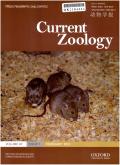Taxonomic, phylogenetic and functional nestedness of mammal assemblages in the Zhoushan Archipelago, China
IF 2
2区 生物学
Q2 ZOOLOGY
引用次数: 0
Abstract
Nestedness is an important part of the theoretical framework of island biogeography and community ecology. However, most previous studies focused on taxonomic dimension and overlooked functional and phylogenetic nestedness. Here, we simultaneously investigated taxonomic, functional, and phylogenetic nestedness of terrestrial mammals on 39 land-bridge islands in the Zhoushan Archipelago, China. As mammals’ response to the environment may depend on their body size, we performed analyses for three mammal assemblages separately: overall species, large and medium species and small species. The taxonomic nestedness was quantified by organizing the species incidence matrix, while the functional and phylogenetic nestedness were estimated by combining the similarity of their ecological traits and phylogeny. Island characteristics (island area, three isolation indices, land use intensity and habitat diversity) and species traits (body size, litter size, habitat specificity, geographic range size and minimum area requirement) were used as predictors of nestedness. Overall and small species were significantly nested in three facets of nestedness, and results supported the selective extinction, selective colonization and habitat nestedness hypotheses. Large and medium species was functionally and phylogenetically nested when matrices were ordered by increasing distance to mainland, supporting the selective colonization hypothesis. Overall, differences in nestedness and its underlying mechanisms were detected not only in three facets of nestedness but also in the three mammal assemblages. Therefore, frameworks that incorporate taxonomic, phylogenetic, and functional nestedness can contribute to a more comprehensive understanding of nestedness processes. Additionally, it also improves our ability to understand divergent responses of mammal assemblages to the insular environment.中国舟山群岛哺乳动物群落的分类、系统发育和功能嵌套性
嵌套性是岛屿生物地理学和群落生态学理论框架的重要组成部分。然而,以往的研究大多侧重于分类维度,而忽略了功能和系统发育的嵌套性。在此,我们同时研究了中国舟山群岛39个陆桥岛屿上陆生哺乳动物的分类、功能和系统发育嵌套性。由于哺乳动物对环境的反应可能取决于它们的体型大小,我们对三种哺乳动物群分别进行了分析:总体物种、大中型物种和小型物种。分类学嵌套度是通过组织物种发生率矩阵来量化的,而功能和系统发育嵌套度则是通过结合其生态学特征和系统发育的相似性来估算的。岛屿特征(岛屿面积、三个隔离指数、土地利用强度和栖息地多样性)和物种特征(体型、产仔数、栖息地特异性、地理范围大小和最小面积要求)被用作嵌套度的预测因子。总体而言,小型物种在嵌套度的三个方面都有明显的嵌套,结果支持选择性灭绝、选择性殖民和栖息地嵌套假说。当矩阵按与大陆的距离递增排序时,大型和中型物种在功能和系统发育上被嵌套,支持选择性殖民假说。总之,不仅在嵌套度的三个方面,而且在三种哺乳动物群中都发现了嵌套度及其内在机制的差异。因此,将分类学、系统发育和功能嵌套性结合起来的框架有助于更全面地了解嵌套过程。此外,它还能提高我们理解哺乳动物群落对海岛环境的不同反应的能力。
本文章由计算机程序翻译,如有差异,请以英文原文为准。
求助全文
约1分钟内获得全文
求助全文
来源期刊

Current Zoology
Agricultural and Biological Sciences-Animal Science and Zoology
CiteScore
3.20
自引率
9.10%
发文量
111
审稿时长
6 weeks
期刊介绍:
About the Journal
Current Zoology (formerly Acta Zoologica Sinica, founded in 1935) is an open access, bimonthly, peer-reviewed international journal of zoology. It publishes review articles and research papers in the fields of ecology, evolution and behaviour.
Current Zoology is sponsored by Institute of Zoology, Chinese Academy of Sciences, along with the China Zoological Society.
 求助内容:
求助内容: 应助结果提醒方式:
应助结果提醒方式:


